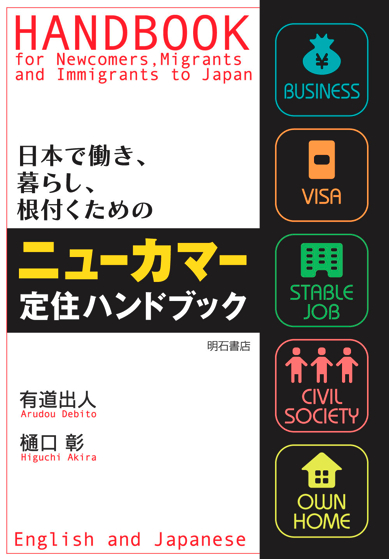mytest





![]()

UPDATES ON TWITTER: arudoudebito
DEBITO.ORG PODCASTS on iTunes, subscribe free
Hi Blog. In a continuation of yesterday’s theme of the GOJ greenmailing away Japan’s negative images, here we have a more overt use of public funds to turn a frown upside down over a disaster: The JET Programme calling on ex-JETs to come back and reprise their role as de facto cultural lobbyists overseas. Except this time there’s an update — the clear aim of sexing up Japan’s image abroad in the wake of the March 11 disasters by dangling an all-expenses-paid trip to the stricken areas.
I have done research on the JET Programme’s role of producing cultural ambassadors before (and its role as a domestic educational force, which I came out in support of in this Japan Times column). But this is the most overt (and in my view, cynical) demonstration I’ve seen yet unmasking the JET Programme’s fundamental intention of burnishing Japan’s image abroad at all costs. As if this is a kind of aid package for the stricken areas: Let them eat good publicity, as part of a program of “Kawaisou Japan”.
Kinda takes the air out of the argument of JET as a program first and foremost promoting domestic education. Arudou Debito
///////////////////////////////////////////////////////
[Sent June 28, 2011]
[Courtesy of an alumnus of the JET Programme, sent to JET Alumni Associations (JETAA) worldwide]
Hello JETAAs,
The Japan Tourism Agency, MOFA, and other local governments in Japan
want to sponsor 20 ex-JETs — who were placed in Iwate, Miyagi,
Fukushima or Sendai — to go back to Japan for one week in order to
see the damages in the afflicted areas, so that when they return to
their home countries, they can let people know what they experienced
there. All expenses are paid (food, travel, insurance, etc.), except
personal expenses.
Unfortunately, because the [redacted] Government still restricts
[redacted] nationals to travel to the regions within 80km of Fukushima
Daiichi, we can’t recommend any ex-JETs who were placed in these
cities or towns.
Applications must be mailed to the Consulate General of Japan in
[redacted] by July 8th, 2011.
Contact [JETAA] Executive for application forms.
[email address redacted]
For more information contact [redacted] at the Consulate.
Thanks!
///////////////////////////////////////////////////////
ENDS
12 comments on “More GOJ greenmailing: JET Alumni Assocs call on 20 ex-JETs for all-expenses paid trip to tsunami areas, to “let people know what they experienced when they return to their home countries””
I don’t have a problem with JET alumni associates. But I see the GOJ’s funding for this self-promoting tour utterly problematic. This will give the detractors a legit reason to call for the end of cultural exchange program– which is already under heavy criticism for giving the spectacles but no effect on teaching in the classroom at all.
The positive side of this, though, is that it provides work for ex-JETs. No one bothers to ask what happens to the current crop of JETs once the jet lands back in their home countries. No one does a census. How many JETs are among the long-term unemployed? How many are underemployed?
There are people within JET looking to reform the program, to make it more relevant to the 21st century. Does this mean being a longer-term “cultural ambassador”, perhaps for a fee? Why not? As long as the role is understood by everybody–including fellow citizens back home in America or wherever.
— There are plenty of ex-JETs who stay employed with the GOJ in the JET organs overseas (and diplomatic fields such as Japanese embassies and consulates within their home countries) to represent Japan and the Programme. But I don’t have statistics.
This could back-fire terribly for the Jgov if any ex-jets have friends still in the area who convey effectively to them any of the fears and concerns resulting from the disaster, and the Jgov’s slow response. Maybe they will go home and say that the situation is really bad, people are worried about food and air safety, and the jgov isn’t seen to be being straight with people?
— How many of them do that now? Most of the vocal ex-JETs I know remain “loyal” to their benefactor, as only their voice is promoted through official channels.
When will people finally understand that JET is not about teaching or education in a school sense of the words. It is to show a western face to Japanese kids so as to not have them freak out as much when dealing with foreign people. It is also to promote Japan overseas. In both these missions JET has been an overwhelming success. None of these facts make the gov’t plan any less revolting: divert attention and money from the actual victims of the nuclear meltdown and tsunami disaster to polish Japan’s image. What about the traumatised thousands who still have no home? Disgusting.
Much as I would dearly love to return to Japan – with or without the disaster and its criminal mishandling – I refuse to be the Japanese government’s propagandist, let alone on a budget that should be going towards relief in the stricken areas. It’s another manifestation of Japan’s generalised response to crises: pretend everything’s alright and get foreigners to gush over the unique Japanese race – without asking any awkward questions, of course.
The response to the disaster is now reaching the point of farce.
The JET programme has always been about propaganda; I was a CIR for two years, and was told from the outset that my role was to have a holiday in Japan, and then return to my home country and rave about how wonderful Japan is to visit (but not to stay). It had absolutely nothing to do with educating local people.
Any why do they need former JETs? Surely the current JETs in place can achieve the same goals? Having recently been up in Ishinomaki for 3 days, it is obvious that the money spent transporting 20 former JETs would be better off spent on tools, winter clothing and kerosene. Sickening.
@Kane,
I think that they need to bring back former JETs because it is just a one-week gig, and then home to blow the horn. Current JETs are needed to teach in those areas. It is hard enough trying to fill the ranks of JET ‘flyjin’, without sending 20 more home to the US or UK.
Incidently, how many JETs left when the Fukushima disaster happened? I would really like to know if the ratio of escaping JETs was above or below the average for NJ.
@Mark Hunter
Sorry, I beg to disagree. The problem is not with how people see the program in general. It’s with the way the JP government implements it in the academic contexts. They’ve got to provide something meaningful and productive to teachers and students in the classroom, if they send JET instructors to Japanese schools for a specific purpose–i.e., serving as an ALT in English class. Due to work visa issue, JET teachers’ role in classroom is significantly limited. JET teachers are not allowed to handle instruction and curriculum as much as Japanese teachers. Most JET teachers are smart enough to know this constraint, and get frustrated with the situation that hampers student’s understanding due to its choatic learning style and a crappy English textbook. Indeed, the JET teachers are very passionate about teaching English to Japanese students. But their voices cannot be taken seriously. Why? Because conservative school district boards and the whimsical education ministry shut off their constructive opinions and criticism. Such arrogance is a typical attitude of Japanese authorities!
— We’re getting too far away from the topic of this blog entry. Please bring it back.
@Jim
Current JETs coming to the end of their tenures would be able to report when they return in August. From my experience as a JET (3 years in Fukushima), there is plenty of flexibility in their working schedules to allow for a week in the disaster areas. The net could even be spread wider and have 40 JETs doing half week stints. My views therefore remain unchanged – I cannot yet see any justification for spending millions of yen of Government money transporting former JETs from around the world whilst the communities that have been smashed by the earthquake and tsunami are crying out for basic supplies. In this case, I feel the Japanese Govt should realise that ‘charity begins at home’.
I agree with Kane. There are still some resources available out in the north. Not all JET teachers who are assigned to local schools have left Japan after 03/11. What’s the point in this free post-quake tour package? Giving ex-JETs visa to stay for helping out local schools and hopefully, work permission to teach elsewhere?? Oh, please. This just doesn’t make any sense.
I started the JET Programme in 2004 naively believing it was a way to teach English and to introduce British culture (or to prove we’re not just about the Beatles, David Beckham, red buses and binge drinking). The idea of the JET Programme is to indoctrinate cultural ambassadors to promote a good image of Japan. That works fine is people do not scratch the surface or try to understand why certain things happen. With me it backfired because I have told people my honest feelings about Japan.
This move however, is typical of Japan’s approach to the world and is probably one of many soft-diplomatic moves to get it a Security Council seat.